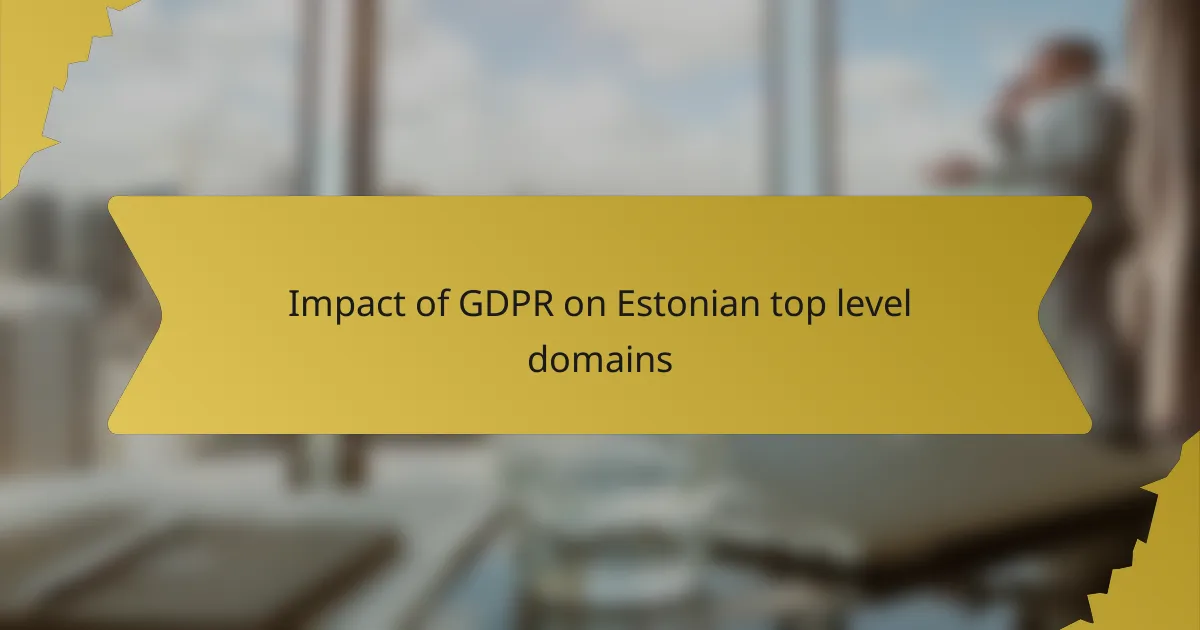The General Data Protection Regulation (GDPR) has a profound impact on Estonian top level domains (TLDs), mandating stricter data protection and privacy measures for domain registrars and owners. Compliance with these regulations is essential to safeguard personal data and avoid potential penalties, prompting website owners in Estonia to adopt more rigorous data handling practices and enhance transparency regarding user information collection and usage.

How does GDPR affect Estonian top level domains?
The General Data Protection Regulation (GDPR) significantly impacts Estonian top level domains (TLDs) by imposing stricter data protection and privacy requirements. This means that domain registrars and owners must ensure compliance with GDPR standards to protect personal data and avoid penalties.
Increased compliance requirements
Estonian TLDs must adhere to GDPR’s rigorous compliance framework, which includes obtaining explicit consent from users before processing their personal data. Domain registrars are required to implement transparent privacy policies and ensure that users are informed about how their data will be used.
Additionally, registrars must appoint a Data Protection Officer (DPO) if they process large amounts of personal data. This role is crucial for overseeing compliance and addressing any data protection issues that may arise.
Impact on data processing practices
GDPR has led to a reevaluation of data processing practices for Estonian TLDs. Registrars must minimize the collection of personal data and only retain it for as long as necessary for legitimate purposes. For example, they should avoid collecting unnecessary information during the domain registration process.
Furthermore, registrars are required to implement robust security measures to protect personal data from breaches. This includes encryption and regular security audits to ensure that data handling practices meet GDPR standards. Failure to comply can result in significant fines, making adherence essential for maintaining trust and legal standing.
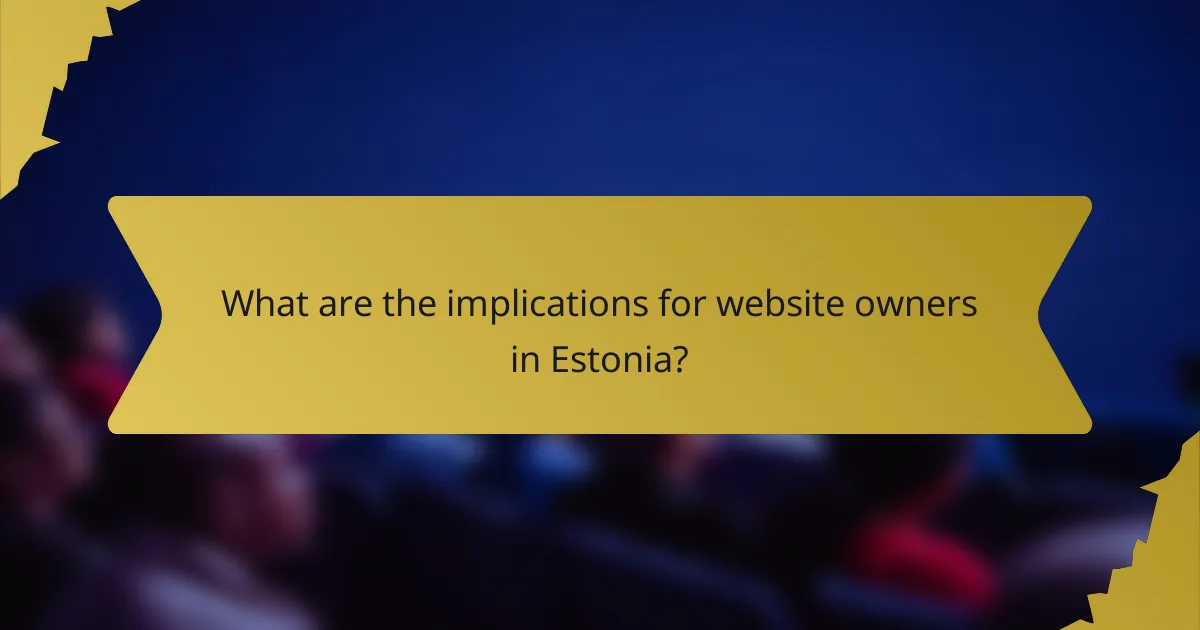
What are the implications for website owners in Estonia?
Website owners in Estonia must adapt to the General Data Protection Regulation (GDPR) by ensuring compliance with data protection laws. This includes implementing stricter data handling practices and being transparent about how user information is collected and used.
Changes in data collection methods
Under GDPR, website owners in Estonia need to revise their data collection methods to prioritize user consent. This means obtaining explicit permission from users before collecting personal data, which can include email addresses, names, and browsing behavior.
Additionally, website owners should consider minimizing the amount of data collected to only what is necessary for their services. For example, instead of gathering extensive user profiles, they might focus on essential information that directly supports their business objectives.
Need for updated privacy policies
Estonian website owners are required to update their privacy policies to reflect GDPR compliance. This includes clearly outlining what data is collected, how it is used, and the rights users have regarding their personal information.
It’s advisable to make privacy policies easily accessible and written in clear language. Regular reviews and updates should be scheduled to ensure ongoing compliance as regulations evolve, and website owners should inform users of any significant changes to these policies.
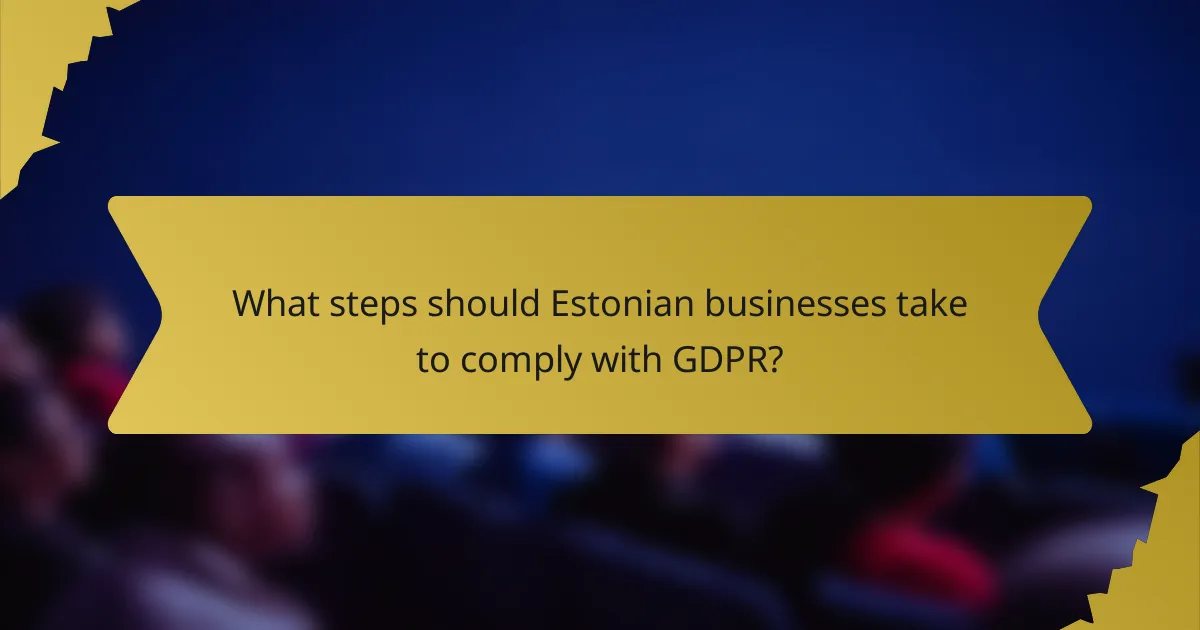
What steps should Estonian businesses take to comply with GDPR?
Estonian businesses must take several key steps to ensure compliance with the General Data Protection Regulation (GDPR). These include conducting thorough data audits and implementing effective user consent mechanisms to protect personal data.
Conduct a data audit
A data audit is essential for identifying what personal data your business collects, processes, and stores. This involves mapping out data flows, determining data sources, and assessing how data is used within your organization.
Establish a clear inventory of all personal data, including customer information, employee records, and any third-party data. This audit should also evaluate data retention policies to ensure compliance with GDPR’s principles of data minimization and storage limitation.
Implement user consent mechanisms
Estonian businesses must implement clear and transparent user consent mechanisms to comply with GDPR. This means obtaining explicit consent from individuals before collecting or processing their personal data.
Consider using checkboxes or opt-in forms that clearly outline what data will be collected and for what purpose. Ensure that users can easily withdraw consent at any time, as this is a critical requirement under GDPR.
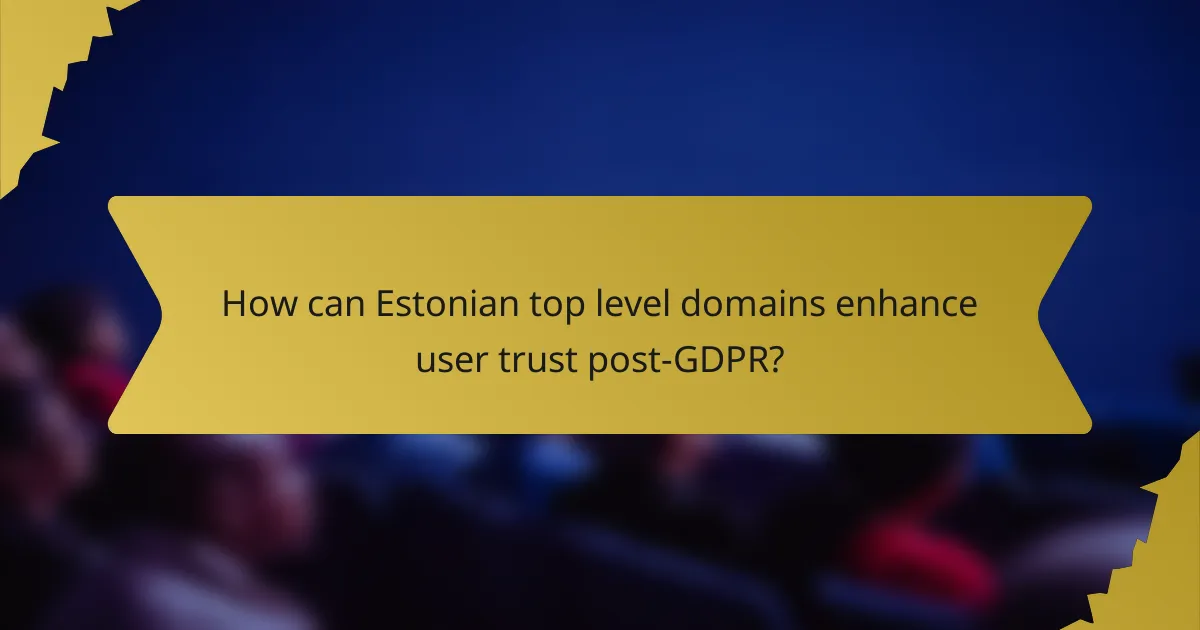
How can Estonian top level domains enhance user trust post-GDPR?
Estonian top level domains can enhance user trust by prioritizing data protection and transparency in compliance with GDPR regulations. By implementing clear data practices, these domains can reassure users about their privacy and security online.
Transparency in data usage
Transparency in data usage is crucial for building trust with users. Estonian top level domains should clearly outline how user data is collected, processed, and stored. This can be achieved through accessible privacy policies that are easy to understand.
For example, domains can provide a summary of data practices on their homepage, linking to detailed privacy statements. Regular updates about any changes in data usage can further enhance user confidence.
Clear communication of privacy rights
Clear communication of privacy rights is essential under GDPR, which grants users specific rights regarding their personal data. Estonian top level domains should inform users about their rights, such as the right to access, rectify, or delete their data.
Providing straightforward guides or FAQs that explain these rights can empower users and foster trust. Additionally, offering easy-to-use tools for users to manage their data preferences can significantly improve user experience and confidence in the domain’s commitment to privacy.
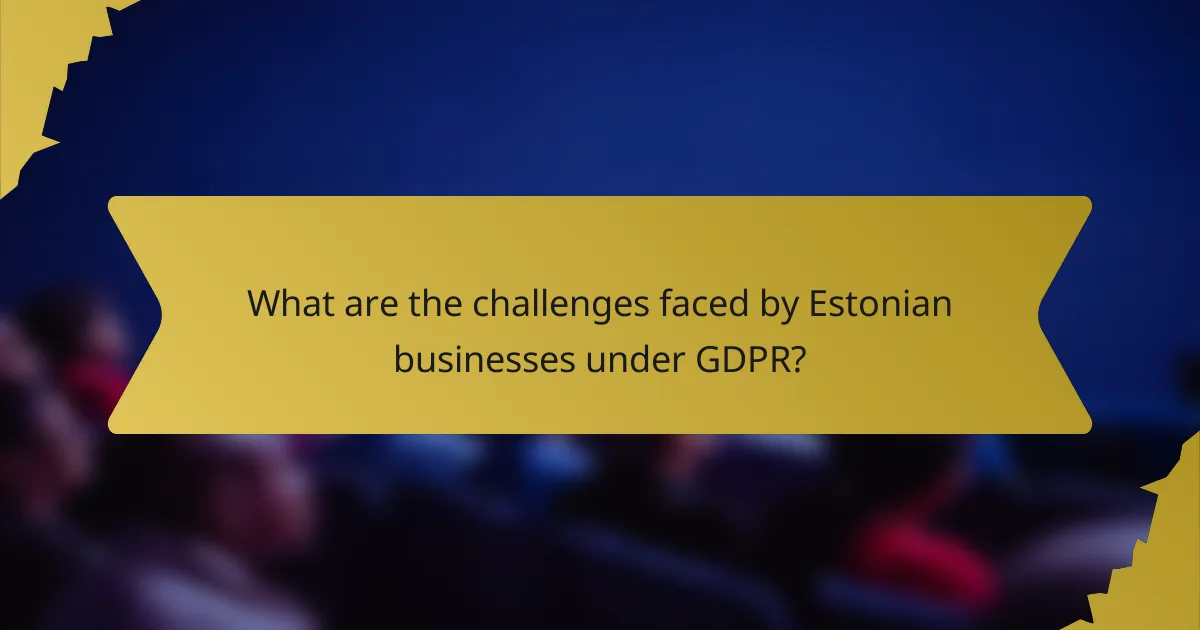
What are the challenges faced by Estonian businesses under GDPR?
Estonian businesses encounter several challenges under the General Data Protection Regulation (GDPR), primarily related to compliance and resource management. The complexity of the regulations and the need for dedicated resources can strain smaller enterprises, impacting their operational efficiency.
Understanding complex regulations
GDPR consists of intricate rules that govern data protection and privacy, making it difficult for businesses to fully grasp their obligations. Companies must ensure they understand requirements such as data subject rights, consent management, and data breach notifications. This complexity often necessitates legal consultation, which can be costly.
For instance, businesses must be aware of the differences between personal data and sensitive data, as the latter requires stricter handling. Failure to comply can lead to significant fines, which can be detrimental to smaller companies.
Resource allocation for compliance
Allocating resources for GDPR compliance can be a significant challenge, especially for small and medium-sized enterprises (SMEs) in Estonia. Many businesses may need to invest in training staff, updating systems, and possibly hiring data protection officers. This investment can strain budgets, particularly for startups or companies with limited cash flow.
To effectively manage these resources, businesses should consider conducting a data audit to identify what personal data they hold and how it is processed. This can help prioritize compliance efforts and allocate resources more efficiently, ensuring that the most critical areas are addressed first.

How does GDPR influence digital marketing strategies in Estonia?
GDPR significantly impacts digital marketing strategies in Estonia by enforcing stricter data protection regulations that require businesses to prioritize user consent and transparency. As a result, marketers must adapt their approaches to comply with these regulations while still effectively reaching their target audiences.
Shift towards consent-based marketing
The shift towards consent-based marketing means that businesses must obtain explicit permission from users before collecting or processing their personal data. This requires clear communication about what data is being collected and how it will be used, which can enhance trust between consumers and brands.
Marketers in Estonia are increasingly implementing strategies such as double opt-in processes for email subscriptions and clear cookie consent banners on websites. These practices not only comply with GDPR but also help build a more engaged audience that feels secure in sharing their information.
Focus on data protection as a selling point
With GDPR emphasizing data protection, businesses can leverage this focus as a unique selling point. Companies that prioritize user privacy can differentiate themselves in a crowded market by showcasing their commitment to safeguarding personal information.
For instance, Estonian companies can highlight their compliance with GDPR in marketing materials, reassuring customers that their data is handled responsibly. This approach can lead to increased customer loyalty and potentially higher conversion rates as consumers become more selective about the brands they trust with their data.
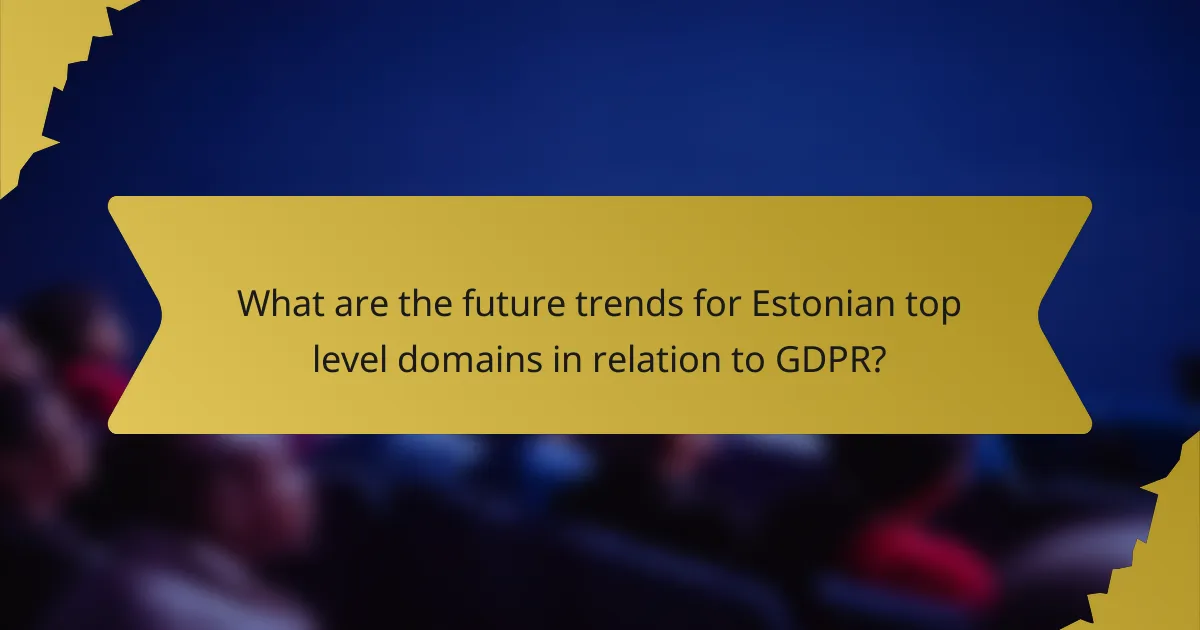
What are the future trends for Estonian top level domains in relation to GDPR?
The future of Estonian top level domains (ccTLDs) will increasingly focus on compliance with GDPR regulations, emphasizing user privacy and data protection. As businesses and individuals navigate these requirements, they will need to adopt practices that align with GDPR standards to maintain trust and legal compliance.
Increased emphasis on data security
With GDPR mandating strict data protection measures, Estonian top level domains will see a heightened focus on data security. Registrars and domain owners must implement robust security protocols to safeguard personal information and comply with legal obligations.
For instance, employing encryption technologies and secure hosting solutions can help protect sensitive data from breaches. Additionally, regular audits and assessments of data handling practices will be essential to ensure ongoing compliance with GDPR standards.
Domain owners should also be aware of the importance of transparency in data processing. Clearly communicating privacy policies and data usage to users can enhance trust and mitigate risks associated with non-compliance.
